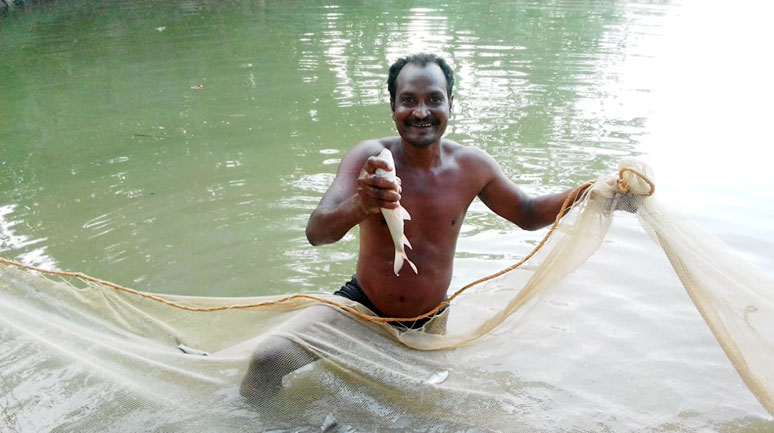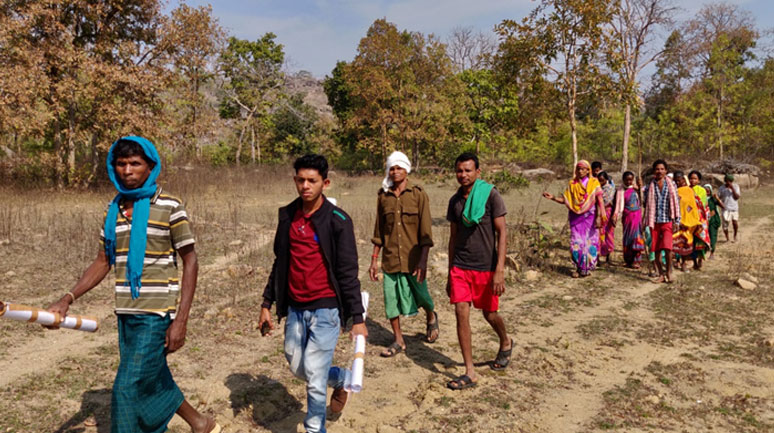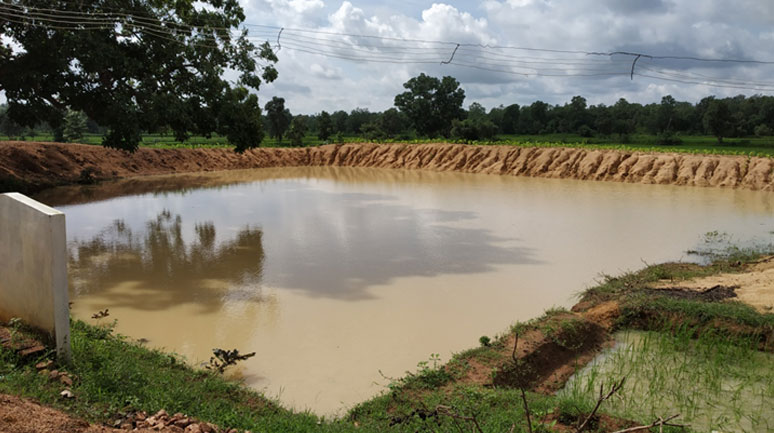Checking Migration, Providing Sustainable Livelihood – MGNREGA goes beyond Employment

Decentralised participatory planning through MGNREGA to create durable livelihood assets like farm ponds, orchards, etc, has helped the farmers to increase their livelihood baskets and stopped distressed migration

PC- Somsingh Kunjam
“Amidst pandemic, every day we are hearing struggles of migrants from different parts of the country, this is very disheartening. My family and I are relieved that today we don't have to migrate out of our village. This is possible because we have work available in our village. Now no one migrates for work”, says Lata Korram, a resident of Masulpani village.
M asulpani, a remote panchayat of Narharpur tehsil in Kanker, Chattisgarh is home to nearly 300 families. It has witnessed numerous instances of its inhabitants migrating to other cities offering employment, in search of work which is indeed ironical since 99% of families in Masulpani own land. However, the produce was excessively low, thus, failing to meet the standards of food sufficiency and leaving the villagers with little choice other than searching for alternative sources of employment. A change in the dire circumstances of the village and its inhabitants was brought in by Mahatma Gandhi Rural Employment Guarantee Act (MGNREGA) which is responsible for transforming the picture of Masulpani in the last 7 years with its major impact being felt during the pandemic providing a sigh of relief to the entire village. Being one of the largest employment generation programmes in the country, MGNREGA, since its inception, aims to provide employment to the rural masses while focusing on checking distress migration via the creation of assets in rural areas.
During the outbreak of COVID 19, MGNREGA is being viewed as one of the prime tools which shall bring about the revival of the rural economy by providing employment. This is expected to be an immediate and short-term relief amidst the ongoing pandemic. Therefore, Central and State governments are emphasizing on the well-designed policy of MGNREGA while encouraging early payments and increasing work demand besides other possible measures. Furthermore, the Finance Ministry's allocation of 40,000 crores additional fund is being viewed as highly promising at this critical period. Despite the hope it provides, employment under MGNREGA is indeed short term and not sustainable in the real sense. There were flaws in planning, execution; timely payment and more importantly the approach practised. Although it provides employment, the assets created, its linkages for income generation and aspiration of rural people were somehow missing. To cope up with these shortcomings, MGNREGA works should primarily focus on the creation of assets for sustainable livelihood promotion. Strengthening rural ecosystem with affluent livelihood asset creation through MGNREGA has been visualised as an opportunity as well as the need of the hour.
Decentralised Planning as a Prime Strategy
I n a tribal majority panchayat like Masulpani, more than 30 percent of the families used to migrate for 6 months to work as agriculture labour for big farmers of Kurud, Bhatagaon and Dhamtari. Though they owned land, they had to migrate in distress. With unpredictable rainfall and no other source of irrigation, farmers suffer significant losses in Kharif agriculture, leading to increased stress level among the farmers. When PRADAN started intervening in the village, there were two major issues- the need for the cash at the village to reduce the migration and improvement of the existing land and water resources so that the assured and sustained income comes from agriculture. This is where MGNREGA has the huge potential and decentralised community-based planning was done for every patch of land and water bodies in the gram panchayat. Decentralised community-based planning is the critical step wherein all the common and individual assets of the village are mapped, gaps and the potential works are being identified to improve the existing assets or create new assets.

Transect walk for patch wise planning of NRM work (PC- Ashutosh Nanda)
I nitially, the (Panchayati Raj Institutions) PRI and the villagers preferred and encouraged community works like community ponds, and roads in the common land. This has relevance with village infrastructure development but it neither addresses individual households' water security nor income generation in large. Due to the lack of perspective and vision, people were hesitant to create small assets like farm ponds and other water harvesting structures in their private lands with the fear of losing their lands. Building perspective for a small structure, awareness regarding water security, irrigation potential was an immediate need in the locale and it involves detailed planning and participation and approval of household. This itself is a tedious process and the administration and gram panchayat would rather prefer to develop assets which could be centrally planned and monitored such as the construction of road under MGNREGA.
PRADAN worked in this direction by engaging with the community while helping them to build their perspective around creating assets for water conservation. Trainings were done to bring change in the perspective of the panchayat and other government officials by giving exposures and showcasing success stories of other land water treated areas. Capacity building and technical support were provided to PRI members, MGNREGA cell and frontline staff on the decentralised planning process, watershed approach like ridge to valley and other support in streamlining the implementation and monitoring of the works. Apart from these, training around GIS-based technologies is imparted to help understand the storage capacity of water harvesting structures, land use pattern, surface water flow to help in the planning of works under MGNREGS.
A co-journey with the administration has been envisaged which shall help the community to understand their resources (land/water, labour, livestock, and forests) and their potential at different levels. Front line staff like mates and GRS are groomed technically on watershed structures. Block officials also have been pro-actively engaged in facilitating the process while attending community meetings wherein key features of NRM based planning and their importance is discussed. Focused group discussions are done with SHG members and other stakeholders (Rozgar Sahayak, Sarpanch, Mates) to identify bottlenecks of existing ways of implementation and searching for possible solutions to it.
MGNREGA is a transformative scheme of the Government. With MGNREGA, people can change the picture of their village. It gives wage for today and sustenance for tomorrow. MGNREGA can strengthen the livelihood of people and can secure future generation by many folds, says Gangaram Kodopi, Masulpani Ex-Sarpanch.
Increase in the Livelihood Basket
A s a result, in last three fiscal years in Masulpani alone, 60 farm ponds and 4 dug wells have been constructed under MGNREGA. NRM works on private lands under MGNREGA are proving to be highly suitable and climate-resilient technology keeping in mind today's scenario. Farm ponds are supporting farmers to use water as protective irrigation in dry spells of monsoon besides lifting water from the pond to undertake transplantation of paddy. The life-saving irrigation in the dry spells has led to the safeguarding of their crops and thus, minimising the losses. The average productivity of paddy has increased from 2 tonnes per hectare to 3 tonnes on an average in Masulpani Panchayat. Besides, farmers have also started growing pulses in the uplands. Fisheries as a new activity have also been added in their livelihood basket. Last year, in Masulpani, 30 families were engaged in fish rearing activities in their farm ponds where the water remains for more than 8 months. This provided additional income of 15,000 on an average to each family. Dhruv Saroj from Masulpani says, “During the entire lockdown, fish in our pond reduced our dependency when markets were locked. We consumed a lot of fish. The fish were in so much abundance that we even supplied to the neighbouring villages. Consumption of fish increased during the lockdown as it was readily available”.
Furthermore, the average labour days of Masulpani are 86.84 as compared to 76.86 days in Narharpur and 54.21 person-days in the state in the last three consecutive financial years. Also, asset creation of more than 50 lakhs has been done in the panchayat along with 130 families (43% of the total families) having received more than 100 days of work in last financial year wherein 96% of the total work done is under Natural Resource Management (NRM) works. Even during these trying times which the outbreak of COVID 19 has exposed us to, the panchayat has sufficient development projects sanctioned out of which 40 projects are already available in the Gram Panchayat which can provide employment to the villagers. “Last year, all the villagers along with PRADAN and MGNREGA staff visited each land in the village to make our plan under MGNREGA. Due to collective visit, we could plan many structures and get them sanctioned. During the last 2 months of lockdown, we had sufficient work in the village. I have already earned for 42 days”, says Kunti Kallo, a resident of Masulpani village.
A Model to Replicate
T he approach and experience of Masulpani has become a model and the ripple effect in last three years could be seen in the entire Narharpur block with the construction of 2200 farm ponds, 1000 land levelling and farm bunding and other livelihood generating assets like poultry and livestock shed. This approach has been instrumental to create sufficient work, ensuring water security for improved agriculture and checking migration. MGNREGA is one of the largest developmental programmes in today’s scenario. The impact is multifaceted as it has the potential to address ecological restoration, water conservation, irrigation and income generation for people. Decentralised planning, people participation, the orientation of PRI and frontline functionaries and involvement of CSOs has a great role to transform the local area economy through MGNREGA by constructing quality assets.

Farm pond in Rajpur village, Masulpani panchayat ( PC Ashutosh Nanda)
T he Chhattisgarh government has initiated two projects for changing the rural landscape through MGNREGA.
One such project is High Impact Mega Watershed Project (an initiative of Bharat Rural Livelihood Foundation- BRLF, Axis Bank Foundation - ABF, and Chhattisgarh government and Ford Foundation). Under this project, decentralised planning, capacity building of front line functionaries and scientific planning based on water security has been conceptualised, so that cropping intensity and income of the people will increase. This project is on a pilot basis and currently implemented in 26 blocks of Chhattisgarh. Under this project in Narharpur block 6172 different in-situ soil and water conservation structures, 800 poultry, piggery and goat sheds are being planned in 45 Gram Panchayat. This has resulted in the block becoming one of the leading blocks in employment generation through majorly NRM works. The average labour days are 76.86 as compared to 54.21 days in Chhattisgarh state on an average and 48.32 person-days in the country in the last three financial years. Labour budget of the block has been increased to 88 % in last three years i.e. 30 crore rupees in FY 2019-20 in comparison to 15.9 crore rupees in FY 2016-17 which is sufficient to provide work to all those in need of employment. In the last financial year, 6376 HH (32% of total HH) have received more than 100 days of work.
Last year, all the villagers along with PRADAN and MGNREGA staff visited each land in the village to make our plan under MGNREGA. Due to collective visit, we could plan many structures and get them sanctioned. During the last 2 months of lockdown, we had sufficient work in the village. I have already earned for 42 days”, says Kunti Kallo, a resident of Masulpani village.
T he second project launched by Chhattisgarh State Government is Narva, Garwa, Ghurwa, Bari (NGGB) - an initiative of the State government to build infrastructure for different resources to boost the local economy) programme. Under this initiative, groundwater level improvement, livestock development, organic manure manufacture and farm development have now started showing positive results. In Narharpur, 718 structures like gabion, gully plug and brushwood are planned to facilitate drainage line treatment to rejuvenate 10 rivulets amounting to Rupees 6.97 crore under this project.
Though the effects of COVID-19 on the agro-based and rural livelihoods are likely to be devastating, panchayat like Masulpani still retains hopes of survival stemming from their ability to cope with conditions like hunger and malnourishment unlike most of their counterparts. This is a result of an alteration in the basic model of MGNREGA by broadening its scope to include asset creation to boost the rural economy in the long run by making it self-sufficient. Thus, this highlights the fact that the whole programme needs to be relooked beyond wages and instead be focused on different agri-allied interventions so that the dire consequences could be minimised to a certain extent.
The abridged version of the article has earlier been published in Village Square
https://www.villagesquare.in/2020/07/01/mgnregs-curbs-distress-migration-provides-employment-during-lockdown/


1 Comment
Great job!